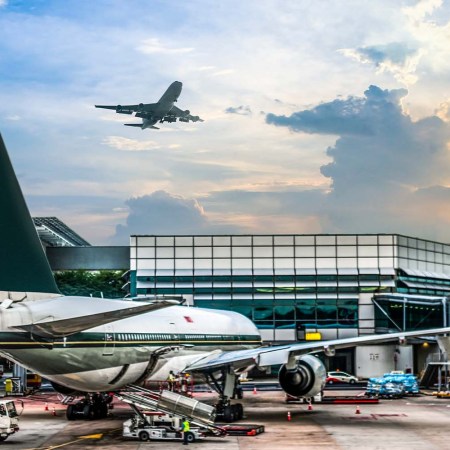It’s now half way through March, which means, for most discerning American adults, we’re just a few days shy of the official start of spring. For others — namely parents of school-aged children and college kids — it also means the highly-anticipated spring break trip.
For the uninitiated, spring break travel season begins around February 17 and continues through April 21 so, chances are, if you count yourself among the latter, your travel plans have already been solidified. That said, TSA has just announced that passenger volume may exceed pre-pandemic levels in the coming weeks, which means that you may still have some prep work to do — if only just of the mental variety.
“In January, we experienced our first full month where travel volumes exceeded the same month in 2019. We fully expect to see an upward trend in travel volumes throughout 2023, including during the spring break period,” said TSA Administrator David Pekoske.
“We coordinate closely with airports and air carriers to prepare for the projected increase in travel volumes and we expect to meet our wait time standards of 30 minutes or less in standard lanes and 10 minutes or less in TSA PreCheck lanes. However, there may be some situations where the capacity of a checkpoint is exceeded.”
In an effort to help travelers arrive prepared for the most efficient TSA checkpoint experience, the agency has offered these spring break travel tips:
5 Reasons Why St. Lucia Should Be Your Spring Break Destination of Choice
Including the natural spring that (might) make you look 12 years younger- Tip 1: Pack smart — start with an empty bag and ensure you do not have any prohibited items. Do not attempt to bring a firearm through a TSA checkpoint; doing so compromises the safety and security of other passengers and our officers in the checkpoint. Other prohibited items include explosives, flammables, knives, razors, replica weapons and more. To avoid delays, passengers should view TSA’s “What Can I Bring?” page and begin packing with a bag that is empty.
- Tip 2: Remember the 3-1-1 Liquids Rule. Passengers may bring a quart-sized bag of liquids, aerosols, gels, creams and pastes through the checkpoint as long as each item is 3.4 ounces or less. Liquids over 3.4 ounces must be packed in a checked bag. Medically necessary liquids, gels and aerosols over 3.4 ounces are allowed in reasonable quantities, but they must be declared at the checkpoint for inspection. TSA allows one liquid hand sanitizer container up to 12 ounces per passenger in carry-on bags until further notice. Sunscreen is not considered to be medically necessary as a carry-on item, so larger quantities of sunscreen must go in checked bags.
- Tip 3: Enroll in TSA PreCheck. In January 2023, 92% of TSA PreCheck passengers waited less than five minutes at TSA checkpoints nationwide. Traveling with the kids? Children 12 and under may join a parent/guardian with TSA PreCheck in the dedicated lanes. Most new enrollees receive a Known Traveler Number (commonly referred to as “KTN”) within five days, and membership lasts for five years. The enrollment fee for five years is $78; online renewals are $70.
- Tip 4: Ask TSA before you travel. Contact TSA’s travel security experts over social media by sending a message to @AskTSA on Twitter or Facebook Messenger. Passengers may also send a text directly to 275-872 (“AskTSA”) on any mobile device. An automated virtual assistant is available 24/7 to answer common questions and AskTSA staff is available from 8 a.m. to 6 p.m. EST daily, including holidays and weekends for more complicated questions.
- Tip 5: Arrive early and carry on kindly. Spring break travelers should give themselves plenty of time to account for traffic, parking, rental car returns, airline check-in, security and making any airport purchases before boarding a flight. Avoid consuming excessive amounts of alcohol prior to boarding, as flight attendants and gate agents may deny boarding to intoxicated passengers.
- Tip 6: Be checkpoint ready. Arrive at the checkpoint lane with a mobile or printed boarding pass and valid ID readily available. When approaching the screening area, remember to empty pockets and place the contents in a bin or carry-on bag. Those without TSA PreCheck must remove large electronics and 3-1-1 liquids from carry-ons. All travelers will be asked to remove outerwear prior to screening.
Further — and this is important — FAA regulations prohibit travelers from consuming alcohol on an aircraft unless served by a flight attendant. Additionally, flight attendants are not permitted to serve a passenger who appears to be intoxicated. Want to check alcohol? By all means: beverages with more than 24% (but not more than 70%) alcohol are limited in checked bags to five liters (1.3 gallons) per passenger, and must be in unopened retail packaging, but alcoholic beverages with 24% alcohol or less are not subject to limitations in checked bags. Passengers may carry on containers of 3.4 ounces or less that can fit comfortably in one quart-sized, clear, zip-top bag.
Just don’t be the inebriated guy doing shots and trying to open the cabin door inflight. There will be plenty of opportunities to imbibe wherever it is that you’re headed…you just have to make it there.
For more travel news, tips and inspo, sign up for InsideHook's weekly travel newsletter, The Journey.



















